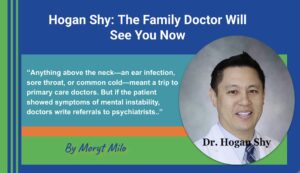 By Moryt Milo
By Moryt Milo
For decades, physical health and mental health were viewed as separate conditions. Anything above the neck—an ear infection, sore throat, or common cold—meant a trip to primary care doctors. But if the patient showed symptoms of mental instability, doctors wrote referrals to psychiatrists.
The practice hasn’t disappeared, but the concept of siloing treatment appears to be turning toward a more holistic approach.
“Internal medicine traditionally focused on physical health and well-being,” Dr. Hogan Shy, who practices internal medicine, said at the Sept. 9 NAMI-Santa Clara County General Meeting. “But there is a larger shift for more holistic treatment and mental health is just so important to well-being in general.”
Shy’s passion toward holistic care is personal. The physician, who is also a NAMI-Santa Clara County board member, said his brother has schizophrenia and his children have mental health challenges. He said it touches everyone in some way.
“Mental health is not an alone problem, it’s a global problem,” he said.
Shy has about 2,000 patients he treats annually and said primary care doctors have a significant number of patients struggling with anxiety and depression. Physicians do see patients with post-traumatic stress disorder (PTSD), bipolar disorder, and schizophrenia but it’s a small number, he noted.
Shy pointed out one of the biggest challenges primary care doctors face is time management. The average time spent with patients is 10 to 15 minutes, which is fine for someone with a sore throat but impractical for someone with a mental health issue.
“You would need 45 minutes to one hour to truly understand what is going on, to diagnose and treat it,” he said.
To complicate matters further, oftentimes there is a physical condition as well as a mental health problem. The challenge is to determine how the two conditions overlap and correctly diagnose the situation, he said.
Shy provided several examples of patients with multiple issues, including a person who was frequently seen for anxiety and panic attacks. During one visit her heart was racing, she had a low-grade fever, and was not feeling well. She was taken to the hospital and diagnosed with hyperthyroidism.
In another instance, Shy saw a 19-year-old male who was irritable, angry, distracted, and showing signs of paranoia, but he also had stomach pain and blood in his stool. He said this patient could have had colitis or Crohn’s disease, but he could also have been struggling with drug abuse or schizophrenia, Shy said.
The challenge was what to prioritize. Shy needed to determine if the physical issues were due to an underlying psychiatric cause or something else. Or if it was a psychiatric emergency that required an involuntary hold (5150) and hospitalization.
Most individuals will go to a general physician first, with some doctors seeing 3,000 patients, Shy said.
“Primary care physicians deliver 60% of mental health care and write 79% of antidepressant prescriptions,” he added.
Primary physicians prescribe SSRIs (medication to treat anxiety, depression, and other mood disorders) but for more severe mental illness like schizophrenia, medical doctors refer patients to psychiatrists.
Except most psychiatrists have wait times of three months or more due to high demand. Many specialists have shifted to private practice rather than staying in a group practice, Shy said, and sessions can cost $300 to $700 out of pocket per session. This makes it prohibitive for many.
To bridge the gap, Shy said primary care doctors will prescribe medication while the patient waits for a psychiatric appointment. He said most internists and family practitioners are skilled in treating depression, anxiety, and substance use like alcohol. Primary care physicians also treat attention-deficit/hyperactivity disorder (ADHD), but it often requires a psychiatric diagnosis.
Comfort Zone
The doctor-patient relationship is another critical facet of medicine. To successfully provide holistic treatment, a patient’s comfort level with his physician is key. Seeing the same provider improves mental health outcomes. If it’s a new doctor, the patient may not be forthcoming about his symptoms. If the doctor knows the history, he may be able to coax information or read beyond what the patient is saying.
Most primary care doctors are comfortable working with patients once they’re stabilized, Shy said. If the patient has a primary physician and a psychiatrist, coordinating patient care creates holistic treatment, especially if something is not working with the medication.
“It comes down to familiarity, different levels of understanding, and treatment,” Shy said. “Every physician has a different comfort level with medications. Some want certain medications to be prescribed only by a psychiatrist.”
In the perfect medical world, Shy said he would have more time to spend with his patients. To achieve this, he suggested nurse practitioners and physician assistants could be trained to treat mental health patients. Leveraging their skills would help improve care.
Most importantly, he said health care needs to get away from reactive care and see the whole person.
“We need to move toward lifetime care,” he said
To watch the entire presentation, click here.










































